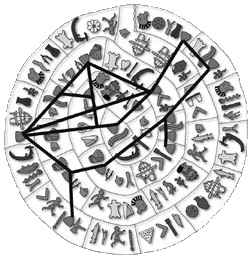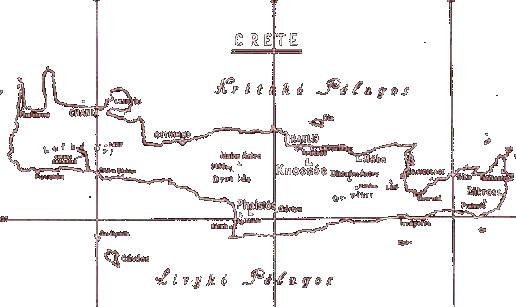Unpacking and publishing the Phaistos Disk since 1993
HOME | PREVIOUS | NEXT | SITEMAP
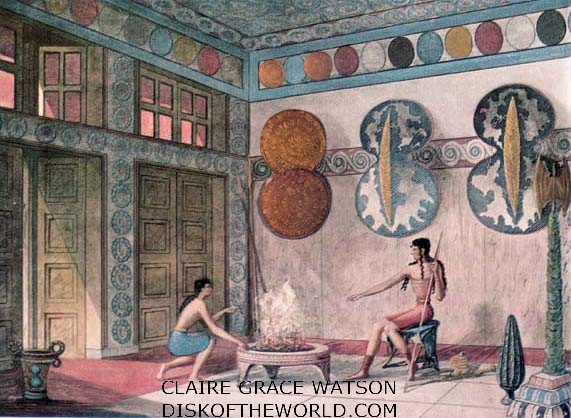
Evidence of Minoan Religion is everywhere in Figure 8 Shields, Wave Spirals, and Disks. Much of their world-view is foreign to us now.
Top is an artist's representation of Disks and Figure 8
Shields in Palace of Minos, Knossos, Crete, Bronze Age (The Palace of Minos, Sir Arthur Evans).
The Phaistos Disk (above), a small and mysterious two-sided pottery art masterpiece, the sides of which
I have overlaid at the connecting line segments, seems to be a fold-out miniturization of the mysterious
Figure 8 Shield. Above, right, is my drawing of the Phaistos Disk with its pictographs removed to show
the overlay at the connecting line segments that reveals a Minoan wave spiral. The disk overlaid and
its pictographs and concealed geometric images help explain the shield, which may be a depiction of the
world as perceived by the Minoans. The shield helps explain the disk, which may be a disk of the world
depicting the Minoan world-view, perhaps including the Minoan Eruption and Tsunami as acts of Goddess.
I would like to explore this possibility and try to connect with an ancient, long forgotten world-view.
I would also like to explore the possibility that the Phaistos Disk is in fact the
legendary Maze of Daedalus. Palace of Minos, the focus of Evan's archaeological exploration, is also
most reknown in mythology as the location of the legendary Maze of Daedalus, which may be preserved in
miniature on the Phaistos Disk, or the Phaistos Disk may be the Maze of Daedalus. Some of the pictographs
on the disk may represent the inventions of Daedalus, if such a person ever existed. The pictographs on the
disk may be a telescope, an astronomer-priest, a pyramid, a volcano, a tsunami wave, a mother goddess,
binoculars (astronomy glasses), and some constellations.
and Caused Her Minoan Eruption
How do you derive something so specific (and fantastical?) as
that title above from something that seems so chaotic as this disk? Geometry is the answer. It is a universal
language that organizes chaos, not just the chaos on this disk but also the lost history that surrounds it.
Click to see larger images of both sides of this 6.25" diameter,
fire hardened, clay disk (ca. 1600 BCE) found in 1908 in the charred ruins of the palace at Phaistos, Crete, and my two
exact tracings of this pottery art masterpiece of miniaturization. The pictographs arranged in a spiral on the disk
were made with tiny clay stamps, most of them repeated. (I accepted this "stamp" theory, along with everyone else. But then, one day, I decided to take the time to check it out and my results disproved it.) These hidden images below are revealed by connecting with lines
the same matching pictographs on the disk.
Image 1 - The sacred cave where
telescope lenses were discovered; Image 2 - A perfect image of the
Constellation Argo; Image 3 -
The star Sirius in the center of the seven planets. Image 4 - Great Pyramid, Exterior
where Minoans practiced astronomy. Image 5 - Great Pyramid, Interior and Subterranean Chamber. Image 6 - Great Pyramid, Apex and Base. Image 7 - Great Pyramid, Two Sides and Base. Image 8 - Right Triangle.
After 15 years as a student in this phenomenal university, I have completed my studies and am now publishing these conclusions.
On my computer are 2GB's of space dedicated to the disk and to images of it involving geometry, astronomy and mythology, but this website contains
only what seems to me to be the most important information. I have learned something about what is involved in understanding this artifact and
I have offered many different decipherments.
The number of decipherments I explored was an attempt on my part to be as thorough as possible and also it was the result of
having to work backwards through time to arrive at understanding. First I explored, by necessity, popular cultural beliefs that were built up
over time, culture after culture, to our modern times' perspective. And each age I researched had its own popular cultural superstitions and
beliefs, many of which were also explored. This is like running a maze, not knowing which way to turn, which theory to embrace, but always
learning something about myself, my ideas, the way I think, my own belief systems.
The picture of the labyrinth is thus offered to us as emblematic of the whole labour of the Great Work, with its two major
difficulties, one the path which must be taken in order to reach the center-where the bitter combat of the two natures takes place-the other
the way the artist must follow in order to emerge. It is there that the thread of Ariadne becomes necessary for him, if he is not to wander
among the winding paths of the task, unable to extricate himself. (Fulcanelli)
I give up on extricating myself from this work that I love. The way I see it, after all this time and meandering through this maze only two
decipherments are possible: absolute and relative. Absolute decipherment refers to what is explicit on the Phaistos Disk for anyone to see and
recognize. I am the only one to see something explicit on the disk that everyone else missed, which encourages some reviewers to suggest it
is not really there. My decipherment is absolute in the sense that anyone could have found the hidden images on the disk if they had thought
to do what I did, simply connect with lines the matching pictographs that produce the images. The images though hidden are explicitly there
once someone realizes to connect the matching, seemingly matching pictographs with lines just in case something emerges that makes sense. At least one thing is
certain from this method; connect-the-dots puzzles have been around since the Phaistos Disk was created.
My definition of absolute decipherment makes me wonder sometimes if the Phaistos Disk is the legendary Philosophers' Stone.
We would point out that this term (Absolum) is close to the Absolute, which is the name by which the ancient alchemists
designated the philosophers' stone. (Walter Lang)
What these hidden images mean, produced from absolute decipherment, is part of relative decipherment, which refers to the
interpretation of what is explicit on the disk. For example, a studied relative decipherment of these four images, derived from this method
of absolute decipherment involving connecting identical pictorgraphs with lines, is that the cave is the Cave of Zeus, the boat is constellation
Argos, the star is Sirius within the seven planets, and the pyramid is the Great Pyramid.
The Phaistos Disk may fit everyone's idea of it simply because it may be a very good small model of the universe - a disk of
the world - and nothing accommodates everyone's point of view so well as the universe. Perhaps this is the whole idea behind the creation
of the disk. If so, it proves itself like a mathematical theorem. If it was intended this way, it certainly is successful. The disk has
more than proved to me that it accommodates whatever decipherment I come up with, and I have come up with quite a few. As long as you stay within the context of the ancient Aegean world, you can come up with a very good relative decipherment.
But back to the absolute decipherment.
By connecting exactly matching, seemingly matching pictographs with lines, many images are revealed that would be hard to
imagine are just randomly there on the disk, even when the disk is a small model of the universe. In most cases I connected the dots in all
the ways possible to arrive at the image displayed, by which I mean I didn't just arbitrarily connect this one to that one, without connecting
it to the other one if I could. This method of decipherment produces images recognizable by everyone everywhere. Therefore, I suggest these
images are archetypes or original models or patterns from which copies were made, or out of which later forms developed. The disk may have
been a model or archetype for other disks, none of which survived or which are still undiscovered.
For nearly 100 years now, individuals have attempted to decipher the disk by reading the pictographs as though they were
hieroglyphs, a method that always produces a relative decipherment, and one which the decipherer is absolutely convinced is the one and only
decipherment. But by reading the signs differently - connecting them together with lines - the decipherer produces an absolute decipherment that
speaks for itself, and which is open to interpretation by anyone who sees it, just as the disk is.
In conclusion, the absolute decipherment of the Phaistos Disk is achieved by connecting matching pictographs with lines to
produce easily identifiable images. This also includes joining the two sides together at the matching line segments to produce the images
associated with the Minoan civilization -- the Minoan wave spiral and the Minoan figure 8 shield. For my relative decipherment of the images
and the pictographs, I stay within the context of the Minoan civilization, where the disk was found. (1) The Phaistos Disk may be the Great Flood artifact of the antediluvian world,
created shortly after the flood/tsunami to record both the event and the explanation for the great catastrophy.
(2) The Minoan inventor Daedalus probably created the Phaistos Disk Maze
of Daedalus, giving us a Wings of Icarus view of his world-view that includes the cosmic calendar he likely invented. If Daedalus never lived,
the name may mean "Inspiration."
(3) Two Minoan astronomer-priests are portrayed on the Phaistos Disk, perhaps Daedalus and his son Icarus, and they
probably represent all the Minoan astronomer-priests during that time.
(4) Daedalus probably invented the telescopes and binoculars used by Minoan astronomer-priests, along with the printing press
technology used to create the disk and even the kiln to fire it, now lost. Alternately, the Phaistos Disk may have been fired in a pottery
factory in Egypt or it may have been "fired" by the fire that burned Phaistos Palace. Everywhere in the ruins Evans found signs of uncontrollable fire – charred beams and pillars, blackened walls, and clay tablets
hardened against time's tooth by the conflagration's heat. (Will Durant)
(5) The Phaistos Disk may be an explanatory historical record of the Minoan eruption and tsunami that devastated the northern
coast of Crete and undermined the fabulous Minoan civilization, giving rise to the legend of Atlantis and its destruction.
(6) Daedalus probably lived, whoever he really was, and he was probably the world's greatest inventor. He is not unlike
Shakespeare, the world's greatest writer, in that we do not know Shakespeare's real identity, either. We know he lived because we have his plays
as proof of it. We can accept the Phaistos Disk as proof of the life of Daedalus and his successor, Icarus, and others who followed in that line.
They probably not only invented or discovered everything evidenced by the Phaistos Disk but also taught it to the Minoans.
(7) Two such disks may have once existed, one found at Phaistos, Crete and one or more placed either in the subterranean
chamber of the Great Pyramid for safekeeping or in
Kephren or Mykerinos. Only the one at Phaistos survived, while the pyramid disk may still be there, undiscovered.
(8) The 240 raised pictographs make the disk itself into a two-sided stamp. Perhaps Daedalus and other astronomers pressed each
side into the sand so they could use it as a teaching tool. It displayed such a remarkable maze it came to be known as the Maze of Daedalus.
Disks like this would be easy to carry and use this way by these "world teachers," who perhaps taught this
world soul creation theology.
(9) The Phaistos Disk Maze of Daedalus contains concepts that become, over a period of three millennium, the basis of Greek
Mythology, Hermeticism, Alchemy, historical religions and modern mysticism. These concepts engendered Pythagoras' idea of the cosmos (kosmos)
and Plato's idea of the World Soul. Although the disk itself remained lost for that period of time, the Inspiration (Daedalus) behind it
continued to guide artists and writers throughout the ages. Following are the six main concepts of the theology that seems to be be
recorded on the Phaistos Disk Maze of Daedalus:
A. The disk of the world (universe) has a rational order based upon a comprehensible structure that can be described using the
universal languages of geometry and mathematics. Inside the octahedron, the top disk rests inside the top pyramid, home of the gods (later on in history the Olympians) and
represents Heaven and Earth while the bottom disk rests inside the pyramid below, the mirror image of above, later on in history described as
home of the Titans - Hades and Tartarus. The Heaven and Earth world is the solar world of light and the daytime; the Hades and Tarturus world
is the lunar world of night and darkness. The disk of the world is surrounded by Oceanus, the cosmic ocean that circumnavigates the universe
and holds everything within it (see above, the wave spiral).
(10) The pictographs on the Phaistos Disk have been found nowhere else in the Minoan civilization. It is possible they were
part of a tattoo language worn by Minoan sailors, who took the language with them
to their graves.
I recently found this on the internet when searching the web for more references to Minoan astronomy than
those pointing to my website. We present the results of orientation studies of important Minoan monuments and our interpretations of their
significance for later Greek astronomy. The studies have been made on the hypothesis that the Minoans, via the Mycenaeans, were the source
of the Greek lunisolar calendar and the use of bright stars to signal when
to begin activities of economic importance, e.g., ploughing and sailing. The palace at Knossos is oriented so that the first rays of the sun at the
equinoxes, as they clear the ridge in the east, will strike an usual concave stone in the floor of the corridor immediately adjacent to the pillar
crypt area in the west wing. This area is generally considered to be the most sacred part of the first palace. The palace at Zakros is
oriented so that from the northern-most corridor of the west wing the moon, as it rose at the southern major standstill, would have been
observed to follow the profile of the ridge opposite at the time when the first palace was built (ca 2000 BC). At two peak sanctuaries near
Zakros, there are walls oriented such that they could have been used to facilitate observations of the heliacal rising and setting and also
the acronychal rising and cosmical setting of the bright star Arcturus ca 1700 BC. In the Minoan ruins of the palaces at Ayia Triada and
Mallia, there was constructed a small building of Mycenaean megaron type. Both are oriented to sunset at the summer solstice. We argue
from these results that the Minoans had begun systematic observations of the sun, the moon and the bright star Arcturus by the end of the
Early Minoan Period (ca 2000 BC). The proximity of Crete to Egypt and the Near East and the documented contact among these regions invite
comparison of the calendrical uses of astronomical knowledge in the three areas in the Bronze Age.
Title: Possible Minoan Contributions to Greek Astronomy
According to recent conclusions by analyists in this field, the Minoan eruption is the
second most catastrophic volcano of the last 5,000 years. This volcano erupted on the island of Thera, now Santorini, in the Aegean Sea
only 70 miles from Crete. According to researchers, the volcano caused a very violent tsunami to hit the northern coast of Crete, destroying the
ships and the ports. Whether or not the eruption destroyed the Minoan civilization is still in debate, but obviously it undermined it.
What took a thousand years to build cannot be rebuilt in only a few years. In an ongoing debate, researchers date the volcanic eruption
sometime between 1650 and 1500 BCE, although recently the date has narrowed to between 1627 and 1600 BCE. The Phaistos Disk is dated about
1700 to 1650 BCE because of the date it acquired from the Linear A tablet found with it in the charred rubble of Phaistos palace.
The spiritual world of the ancient Egyptians is not immediately understandable by the western civilizations of the
twentieth century...We may find it ridiculous for artists to represent the sky as a cow, or for a beetle to be venerated as a symbol of the sun
god, but in past ages, among peoples having a mythical view of the world, the formative principle was not of logic but of an outlook governed by
images...The whole symbolic evocation rests upon the supposed, and in the end actual, correspondence of things, on the relationship between
microcosm and macrocosm as intuitively understood by the mind and visually by the eye...The ancient Egyptians, the Babylonians, and to some
extent the Greeks, used images; their view of the world was a comprehensive one.
...A symbol has manifold significance and therefore its origin and purpose cannot often be explained satisfactorily.
Sometimes the symbol seems to contradict itself. There are, in fact, symbols which refer to both poles of existence: life and death, good and
evil. (Introduction, The Gods and Symbols of Ancient Egypt, Manfred Lurker, Thames and Hudson, publishers, 1974.)
As example of contradictory symbols, suppose this equilateral triangle is a pictograph of the volcano
(right) filled with 20 pieces of molten rock and ash. It may also represent the icosahedron, later to become one of the
five Platonic solids, an equilateral triangle composed of 20 equilateral triangles. What would be the relationship between the three?
What may have been an obvious relationship to the Minoans would be, for us, as strange as thinking a cow also represents the sky.
But would our world be any less mystifying to the Minoans if they could study us as we study them? Would they not go nuts trying to
comprehend what we intend by all our corporate symbols? Maybe some civilization in the distant future will forget the purpose of
corporations but still raise up a bunch of scholars who claim to decipher the strange symbols and hold endless debates as to their meanings.
If this image (far left and up above) represents an exterior view of both the Great Pyramid and the
great volcano, then by using intuition we can understand it. They look similar, they are both monumental in the Bronze Age, one as a
creation and the other as a goddess-made destruction. It may even be that the Minoans believed that viewing the goddess
(2nd left) with their telescopes (3rd left) from within the pyramid, and climbing to the top of the
pyramid to get nearer to her, unveiled her so extensively that she was offended and she assaulted their world with her tsunami
(the wave pictograph, 4th left, and the spirals on the disk), that emanated from the center of the volcano which is also the
center of the disk (see up above). Perhaps they hypothesized that the Great Pyramid itself was offensive to her.
(Click the pyramid to see a larger image.)
This could be the precursor, even the foundation, of the Biblical story of the Tower of Babel.
In the Bronze Age, the astronomers got too close to the goddess, like Icarus who flew so high that Ra melted his wings. Because she was
displeased with them she made a volcano erupt in a time when no one had ever seen or heard of such a thing. It must have seemed like the
end of the world, brought about by an angry goddess. Later on, perhaps in a Bible transformation, the goddess became god and the Great Pyramid
became the Tower of Babel.
How would such a catastrophy as the Minoan eruption be interpreted by people in the Bronze Age? We have scientists to tell us
about these things and so did the Minoans, but their science was interwoven with their theology, so that an event of this magnitude would be
interpreted as an act of goddess. The ten plagues of Egypt, as example, were interpreted within a theological context but in actuality they
may have been the result of the Minoan eruption. That theory is not widely accepted due to the differences in the dates of the Exodus (1450 BCE)
and the eruption (1628 BCE), but it is normal human behavior to interpret cataclysmic events as apocalyptic. Today our general education and
knowledge about things and the past allows us to reverse some apocalypses. Lately, we have begun to interpret the destruction of Atlantis
within the context of our knowledge of the Minoan eruption. We are assisted in this interpretation by the phenomenal Minoan culture that
seems to us to be too advanced for the times so that it must have been Atlantis.
Now that we have the final piece, the technology of the Minoans, in place it seems quite possible to conclude that the fabled civilization of Atlantis perhaps was Minoan Crete.
In the great legend, Atlantis was destroyed because they
offended the gods with their technology, and here we have on the Phaistos Disk the idea of it, that the Minoan-astronomer priests took
their theology to such heights, literally and figuratively, that they understood completely the creation of the universe and their place within it.
But they understood it via their man-made technology, their telescopes, their
binoculars, their astronomical measuring devices (left), things the goddess did not grant them at birth but that they
acquired on their own, like little gods. The knowledge they gained from these devices was self-derived as they peered into her and measured
her and performed vivisection via astronomy. Is this how they offended her so that she set out to punish them? Like God granting humanity the
favor of punishment, rather than total destruction, in his gift of Noah's Ark, the Goddess granted Minoans salvation through her gift of ships,
symbolized by the Constellation Argo on the disk (right). There we see Jason's ark, loaded with Argonauts (Arkonauts),
Minyae and other life indigenous to Minoan Crete, riding the spiral wave of the tsunami and all around them the people and things swept away by
the tsunami to float in the waters of the Aegean Sea.
If only we could look back in time, back through the stars, we might see the civilization of Minoan Crete and the people arriving at
Knossos Palace before the flood. From the perspective of the ancient Greeks, who spread the Atlantis story so effectively that all the
world knows it, a fabulous civilization did really exist out in the ocean, or under it as the story goes. But that could be because of the
Minoan buildings and upside-down Doric columns swept to the bottom of the sea by the tsunami, to be explored in the aftermath by divers
looking for loot and stories to tell of fishes swimming amongst the ruins of a lost city under the sea. Atlantis, and its human-devised
technology, was destroyed because it overstepped its boundaries into those of the divine, and this could have been the interpretation given to
the tsunami by the Minoans who, lacking the science of Tectonics, had no other methods of understanding it. (Above, viaduct
entrance to the Palace of Knossos.)
For many researchers who study the Minoan civilization, the story of Atlantis must surely be a story about Minoan Crete,
and the Phaistos Disk may well be a story of the Minoan eruption. Fortunately for us, Daedalus may have included on the disk not only the
story of how the goddess attacked them with volcano and tsunami, but also he recorded the knowledge the astronomer-priests acquired via their
offensive technology that so angered her. Part of their interpretation of the volcano and tsunami could be that the goddess was jealous of them
because their civilization was so beautiful that it competed with her own beauty. Later on in Greek mythology we see this theme quite a bit.
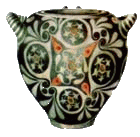 The Phaistos Disk is like much of the pottery from this civilization in that it too has a geometric orientation (left, Minoan polychrome pot, Knossos).
Geometric images concealed on the disk and revealed by connecting matching pictographs, reveal an exterior view and an interior view of a
pyramid, the constellation Argo, a star inside seven planets (pentagram inside heptagon), and an inward spiraling cave (where telescope
lenses were found in Crete). Because of these findings and suppositions, this presentation is entitled:
The Phaistos Disk is like much of the pottery from this civilization in that it too has a geometric orientation (left, Minoan polychrome pot, Knossos).
Geometric images concealed on the disk and revealed by connecting matching pictographs, reveal an exterior view and an interior view of a
pyramid, the constellation Argo, a star inside seven planets (pentagram inside heptagon), and an inward spiraling cave (where telescope
lenses were found in Crete). Because of these findings and suppositions, this presentation is entitled:
PHAISTOS DISK MAZE OF DAEDALUS![]() MINOAN ASTRONOMER-PRIESTS WITH TELESCOPES
MINOAN ASTRONOMER-PRIESTS WITH TELESCOPES![]()
![]() Goddess
Goddess
with their Astronomy ![]() and Tsunami
and Tsunami
![]()
This could be the Great Flood Artifact of the Antediluvian World
It may be an Artifact of Archaeoastronomy,
ca. 1600 BCE
Conclusions and Illustrations by
Claire Grace Watson, B.A., M.S.T.
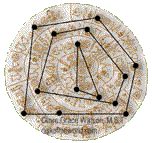
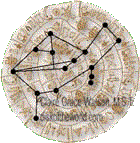
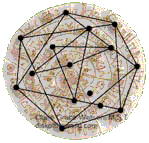
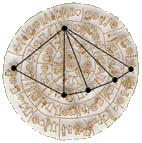
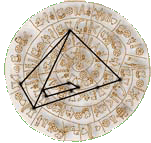
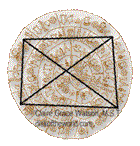
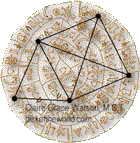
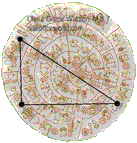
The 60 Line Segments Removed
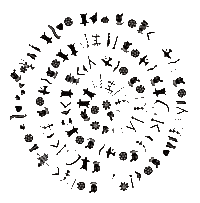
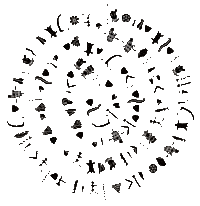
 The Phaistos Disk provided me an opportunity to study material outside the realm of English literature but within the realm of my first love, mythology.
This new material included geometry, mathematics, archaeology, astronomy, ancient pictographs, and the antique science of
containment of geometrical arrangements. The Phaistos Disk taught me plane geometry as it
existed before Euclid complicated it, when he got hold of it 1,300 years after the disk was created, and before the Georgia school systems
tried to teach it to me with no success 3,600 years later. Geometry is a universal language providing a portal into this Minoan world so
old that the Greek poet Homer in 700 BCE called it ancient and forgotten.
The Phaistos Disk provided me an opportunity to study material outside the realm of English literature but within the realm of my first love, mythology.
This new material included geometry, mathematics, archaeology, astronomy, ancient pictographs, and the antique science of
containment of geometrical arrangements. The Phaistos Disk taught me plane geometry as it
existed before Euclid complicated it, when he got hold of it 1,300 years after the disk was created, and before the Georgia school systems
tried to teach it to me with no success 3,600 years later. Geometry is a universal language providing a portal into this Minoan world so
old that the Greek poet Homer in 700 BCE called it ancient and forgotten.
![]() As for the pictographs,
all decipherments of the pictographs are relative decipherments because they must always arise from the decipherer's personal perspective,
cumulative knowledge, and area of research. For example, a linguist deciphers the pictographs as an ancient language, an historian might say the
disk hails from somewhere other than Crete, a board game collector deciphers the disk as an ancient game, an Ancient Egypt enthusiast deciphers the
disk as an Egyptian myth (that one is mine), an admirer of Linear B deciphers the disk as more Linear A, a calendar researcher deciphers the disk as
an ancient calendar (me also), a computer programmer deciphers the disk as an ancient computer disk, and a UFO researcher finds a UFO on the
disk and deciphers the disk as an alien artifact (me again). The number of decipherments possible has a correlation to the number of people
who try to decipher it. How can the Phaistos Disk accommodate so well all the different versions of it? I think I know.
As for the pictographs,
all decipherments of the pictographs are relative decipherments because they must always arise from the decipherer's personal perspective,
cumulative knowledge, and area of research. For example, a linguist deciphers the pictographs as an ancient language, an historian might say the
disk hails from somewhere other than Crete, a board game collector deciphers the disk as an ancient game, an Ancient Egypt enthusiast deciphers the
disk as an Egyptian myth (that one is mine), an admirer of Linear B deciphers the disk as more Linear A, a calendar researcher deciphers the disk as
an ancient calendar (me also), a computer programmer deciphers the disk as an ancient computer disk, and a UFO researcher finds a UFO on the
disk and deciphers the disk as an alien artifact (me again). The number of decipherments possible has a correlation to the number of people
who try to decipher it. How can the Phaistos Disk accommodate so well all the different versions of it? I think I know.
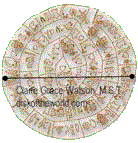
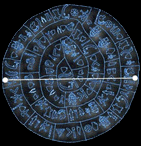
B. The disk of the world has two harmonious opposites, one part is a reflection of the other one and existing as a mirror image or a spirit twin.
C. The disk of the world is comprised of pre-existant and eternal archetypes that are mirrored in the stars as constellations.
D. The disk of the world and thus the stars that circumnavigate the Pole Star are spinning in an infinite spiral.
E. The spin creates projections of the pre-existantant geometrical forms and these become the impermanent physical world.
(Click the image above to see an example.)
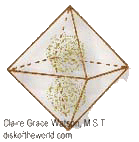 F. The disk of the world is
spinning through the Void inside an octahedron (right).
F. The disk of the world is
spinning through the Void inside an octahedron (right).
 "...in those days [of ancient Egypt] of initiate kings and rulers and sages who occupied themselves with the Sacred Science,
when the clear Aether spake face to face with them without disguise, or holding back aught, in answer to their deep scrutiny of holy things...In those
days so great was their love of the holy mysteries, so high their virtue, that they left the earth below them, and in their deathless souls
became 'heaven-walkers' and knowers of things divine." (Thrice-Greatest Hermes, G.R.S. Mead)
"...in those days [of ancient Egypt] of initiate kings and rulers and sages who occupied themselves with the Sacred Science,
when the clear Aether spake face to face with them without disguise, or holding back aught, in answer to their deep scrutiny of holy things...In those
days so great was their love of the holy mysteries, so high their virtue, that they left the earth below them, and in their deathless souls
became 'heaven-walkers' and knowers of things divine." (Thrice-Greatest Hermes, G.R.S. Mead)
Authors: Henriksson, G.; Blomberg, M.
Affiliation: AA(Astronomical Observatory, Box 515, S-751 20 Uppsala, Sweden), AB(Department of Classical Archaeology and Ancient History,
Uppsala University, S:t Erikstorg 5, Uppsala, S-75310 Sweden)
Publication: Joint European and National Astronomical Meeting, JENAM-97. 6th European and 3rd Hellenic Astronomical Conference, held in
Thessaloniki, Greece, 2-5 July, 1997, Meeting Abstract, p. 332.
Publication Date: 00/1997
Origin: AUTHOR
Bibliographic Code: 1997jena.confE.332H
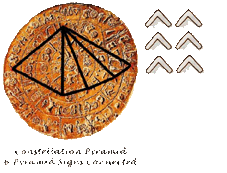 We may never know the actual date of the creation of the Phaistos Disk, but because it may be a record of the volcano and the
tsunami we perhaps can use the disk to help date the volcano, and vice versa. The Great Pyramid on the disk might also represent the volcano.
Because of the size of this historic record, only a little over 6" diameter, and because of the times in which it was created, when syncretisms were
in use more than now, this image and the others on the disk can represent two or more things/ideas. In the following two paragraphs, Manfred Lurker
writes about syncretism in reference to ancient Egypt but which can certainly apply to Minoan Crete.
We may never know the actual date of the creation of the Phaistos Disk, but because it may be a record of the volcano and the
tsunami we perhaps can use the disk to help date the volcano, and vice versa. The Great Pyramid on the disk might also represent the volcano.
Because of the size of this historic record, only a little over 6" diameter, and because of the times in which it was created, when syncretisms were
in use more than now, this image and the others on the disk can represent two or more things/ideas. In the following two paragraphs, Manfred Lurker
writes about syncretism in reference to ancient Egypt but which can certainly apply to Minoan Crete.

![]()
![]()
![]()
![]()
![]()
![]()
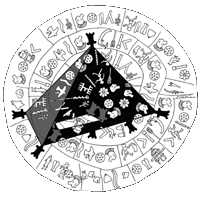
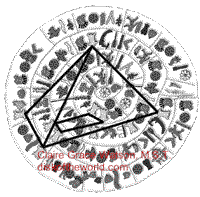 In another pyramid image, an interior
view, also found on the same side of the disk as the other pyramid (above right and right) by connecting all 10 identical
golden fleece signs (5th left), the golden fleece representing perhaps the pursuit of knowledge and understanding, the
goddess is highlighted by a door leading to a lower level. This seems to confirm the idea that their purpose for being at the pyramid was to
get a closer look at her and that she was at the "bottom" of the Minoan eruption, i.e. causing it. The Phaistos Disk was found in a room with a
trap door entrance. This trap door in the pyramid may indicate the astronomer-priests placed another disk in the subterranean chamber of the
Great Pyramid, perhaps for safe keeping, as a record of the Minoan eruption and tsunami and their explanation of why it happened. Alternately,
this second pyramid may be Kephren.
In another pyramid image, an interior
view, also found on the same side of the disk as the other pyramid (above right and right) by connecting all 10 identical
golden fleece signs (5th left), the golden fleece representing perhaps the pursuit of knowledge and understanding, the
goddess is highlighted by a door leading to a lower level. This seems to confirm the idea that their purpose for being at the pyramid was to
get a closer look at her and that she was at the "bottom" of the Minoan eruption, i.e. causing it. The Phaistos Disk was found in a room with a
trap door entrance. This trap door in the pyramid may indicate the astronomer-priests placed another disk in the subterranean chamber of the
Great Pyramid, perhaps for safe keeping, as a record of the Minoan eruption and tsunami and their explanation of why it happened. Alternately,
this second pyramid may be Kephren.
![]()
![]()
![]()
![]()
